#21. Getty Center
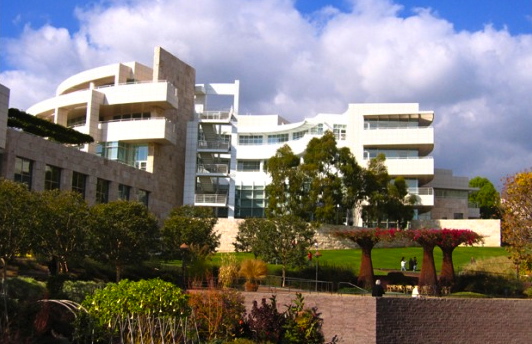
Getty Museum in Los Angeles, California (HD)
The Getty Center, in Brentwood, Los Angeles, California, is one of two locations of the J. Paul Getty Museum. The museum’s permanent collection includes “pre-20th-century European paintings, drawings, illuminated manuscripts, sculpture, and decorative arts; and 19th- and 20th-century American and European photographs”. Among the works on display is the painting Irises by Vincent van Gogh. The Center, which opened on December 16, 1997, is also well known for its architecture, gardens, and views (overlooking Los Angeles). Besides the Museum, the Center’s buildings house the Getty Research Institute, the Getty Conservation Institute, the Getty Foundation, and the administrative offices of the J. Paul Getty Trust, which owns and operates the Center.
 Getty Center Location: Los Angeles, CA Architect: Richard Meier Year: 1997
Getty Center Location: Los Angeles, CA Architect: Richard Meier Year: 1997
Pritzker winning architect Richard Meier (1984) pulled off a remarkable feat with the Getty Center in Los Angeles. Despite enormous success prior to the commission, the Getty is what catapulted Meier into mainstream popularity. Combining architecture and gardens (and of course a range of more defined facilities), the Center is renowned for its views of Los Angeles.
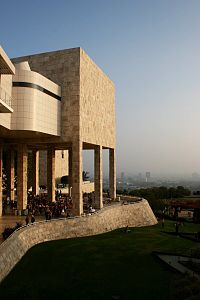 The Getty Center Exhibitions Pavilion.
The Getty Center Exhibitions Pavilion.
The Getty Center, in Brentwood, Los Angeles, California, is a campus for the J. Paul Getty Trust founded by oilman J. Paul Getty. The $1.3 billion center, which opened on December 16, 1997, is also well known for its architecture, gardens, and views overlooking Los Angeles. The center sits atop a hill connected to a visitors’ parking garage at the bottom of the hill by a three-car, cable-pulled hovertrain funicular. The center draws 1.3 million visitors annually.
It is one of two locations of the J. Paul Getty Museum. This branch of the museum specializes in “pre-20th-century European paintings, drawings, illuminated manuscripts, sculpture, and decorative arts; and 19th- and 20th-century American and European photographs.” Among the works on display is the painting Irises by Vincent van Gogh. Besides the museum, the center’s buildings house the Getty Research Institute (GRI), the Getty Conservation Institute, the Getty Foundation, and the administrative offices of the J. Paul Getty Trust, which owns and operates the center. The center also has outdoor sculptures displayed on terraces and in gardens. Designed by architect Richard Meier, the campus includes a central garden designed by artist Robert Irwin. GRI’s separate building contains a research library with over 900,000 volumes and two million photographs of art and architecture. The center’s design included special provisions to address concerns regarding earthquakes and fires.
Location and history
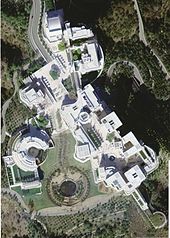 USGS satellite image of the Getty Center. The circular building to the left is the Getty Research Institute. The two buildings at the top are the Getty Trust administrative offices and the rest is the museum.
USGS satellite image of the Getty Center. The circular building to the left is the Getty Research Institute. The two buildings at the top are the Getty Trust administrative offices and the rest is the museum.
Originally, the Getty Museum started in J. Paul Getty‘s house located in Pacific Palisades in 1954. He expanded the house with a museum wing. In the 1970s, Getty built a replica of an Italian villa on his home’s property to better house his collection, which opened in 1974. After Getty’s death in 1976, the entire property was turned over to the Getty Trust for museum purposes. However, the collection outgrew the site, which has since been renamed the Getty Villa, and management sought a location more accessible to Los Angeles. The purchase of the land upon which the center is located, a campus of 24 acres (9.7 ha) on a 110-acre (45 ha) site in the Santa Monica Mountains above Interstate 405, surrounded by 600 acres (240 ha) kept in a natural state, was announced in 1983. The site cost $25 million. The top of the hill is 900 feet (270 m) above I-405, high enough that on a clear day it is possible to see not only the Los Angeles skyline but also the San Bernardino Mountains and San Gabriel Mountains to the east as well as the Pacific Oceanto the west.
In 1984, Richard Meier was chosen to be the architect of the center. After an extensive conditional-use permit process, construction by the Hathaway Dinwiddie Construction Company began in August 1989. The construction was significantly delayed, with the planned completion date moved from 1988 to 1995 (as of 1990). By 1995, however, the campus was described as only “more than halfway complete.”
The center finally opened to the public on December 16, 1997. Although the total project cost was estimated to be $350 million as of 1990, it was later estimated to be $1.3 billion. After the center opened, the villa closed for extensive renovations and reopened on January 28, 2006, to focus on the arts and cultures of ancient Greece, Rome, and Etruria. Currently, the museum displays collections at both the Getty Center and the Getty Villa in Pacific Palisades.
In 2005, after a series of articles in the Los Angeles Times about the spending practices of the Getty Trust and its then-president Dr. Barry Munitz, the California Attorney General conducted an investigation of the Getty Trust and found that no laws had been broken. The trust agreed to appoint an outside monitor to review future expenditures. The Getty Trust experienced financial difficulties in 2008 and 2009 and cut 205 of 1,487 budgeted staff positions to reduce expenses. Although the Getty Trust endowment reached $6.4 billion in 2007, it dropped to $4.5 billion in 2009.
Architecture
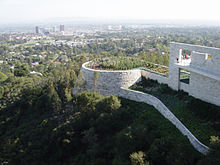 Cactus Garden perched on the south of the Getty Center, with West Los Angeles in the background
Cactus Garden perched on the south of the Getty Center, with West Los Angeles in the background
Meier has exploited the two naturally-occurring ridges (which diverge at a 22.5 degree angle) by overlaying two grids along these axes. These grids serve to define the space of the campus while dividing the import of the buildings on it. Along one axis lie the galleries and along the other axis lie the administrative buildings. Meier emphasized the two competing grids by constructing strong view lines through the campus. The main north-south axis starts with the helipad, then includes a narrow walkway between the auditorium and north buildings, continues past the elevator kiosk to the tram station, through the rotunda, past the walls and support columns of the exhibitions pavilion, and finally the ramp besides the west pavilion and the central garden. Its corresponding east-west visual axis starts with the edge of the scholar’s wing of the Getty Research Institute (GRI), the walkway between the central garden and the GRI, the overlook to the azalea pool in the central garden, the walkway between the central garden and the west pavilion, and finally the north wall of the west pavilion and the courtyard between the south and east pavilions.
The main axes of the museum grid that is offset by 22.5 degrees begins with the arrival plaza, carries through the edge of the stairs up to the main entrance, aligns with the columns supporting the rotunda as well as the center point of the rotunda, aligns with travertine benches in the courtyard between the pavilions, includes a narrow walkway between the west and south pavilions, a staircase down to the catus garden and ends in the garden. The corresponding cross axis starts with the center point of the circle forming the GRI library garden, then passing to the center of the entrance rotunda, and aligning with the south wall of the rotunda building. Although all of the museum is aligned on these alternative axes, portions of the exhibitions pavilion and the east pavilion are aligned on the true north-south axis as a reminder that both grids are present in the campus.
The primary grid structure is a 30-inch (760 mm) square; most wall and floor elements are 30-inch (760 mm) squares or some derivative thereof. The buildings at the Getty Center are made from concrete and steel with either travertine or aluminium cladding. Around 1,200,000 square feet (110,000 m2) of travertine was used to build the center.
Throughout the campus, numerous fountains provide white noise as a background. The initial design has remained intact; however benches and fences have been installed around the plaza fountains to discourage visitors from wading into the pools. Some additional revisions have been made in deference to the Americans with Disabilities Act.
 The fountain at the tram station.
The fountain at the tram station.
The north promontory is anchored by a circular grass area, which serves as a heliport in case of emergencies, and the south promontory is anchored by a succulent plant and cactus garden. The complex is also encircled by access roads that lead to loading docks and staff parking garages on both the west and east sides of the buildings. The hillside around the complex has been planted with California Live Oak (Quercus agrifolia) trees.
The museum has a seven-story deep underground parking garage with over 1,200 parking spaces. Its roof has an outdoor sculpture garden. An automated three-car, cable-pulled hovertrain funicular takes passengers between the parking garage at the bottom of the hill and the museum at the top of the hill.
Arrival court and central rotunda
 A stairway leading down to the Central Garden
A stairway leading down to the Central Garden
Visitors typically arrive at a tram station in the arrival plaza located between the administrative buildings and the museum entrance. A large set of steps leads to the main doors of the rotunda building. The rotunda building houses information desks, two orientation theatres and museum shops. It also holds a grand staircase that starts a path toward the paintings located on the second floor of each art pavilion. The rotunda opens to the south to a terrace that links all five of the museum pavilions. A separate building to the west of the arrival plaza and stairs holds a cafeteria and restaurant. Next to the restaurant is a stone arch, which separates the museum from the GRI. Stairs from the terrace connecting the GRI and the restaurant lead down to the central garden.
The J. Paul Getty Museum‘s estimated 1.3 million visitors annually make it one of the most visited museums in the United States. The collection of the J. Paul Getty Museum on display at the Getty Center includes “pre-20th-century European paintings, drawings, illuminated manuscripts, sculpture, and decorative arts; and 19th- and 20th-century American and European photographs.” The paintings include:
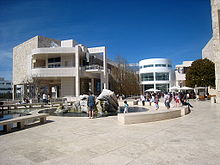 Terrace between pavilions looking toward Exhibitions Pavilion and Rotunda.
Terrace between pavilions looking toward Exhibitions Pavilion and Rotunda.
- Arii Matamoe (The Royal End) by Paul Gauguin (1892). The Museum’s director, Michael Brand, stated that the purchase of the painting was “one of the key moments in the history of our collection.” The literal translation of the Tahitian words of the title are “noble” and “sleeping eyes”, which implies “death.”
- Irises by Vincent van Gogh (1889). The museum purchased the painting in 1990; it had sold for $53.9 million in 1987.
- Portrait of a Halberdier by Pontormo (1528–1530). When the museum bought the painting for $35.2 million at an auction in 1989, “the price more than tripled the previous record at auction for an Old Master painting.”
- A copy of Portrait of Louis XIV, which measures 114 x 62-5/8 inches, by the workshop of Hyacinthe Rigaud (after 1701).
Getty’s photograph collection is located on the lower level of the west pavilion. It includes 35,000 individual prints, 1,500 daguerreotypes and other cased objects, 30,000 stereographs and cartes-de-visite, and 475 albums containing almost 40,000 mounted prints.
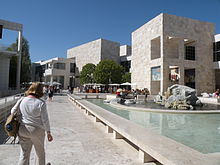 The inner courtyard of the museum
The inner courtyard of the museum
The museum building consists of a three-level base building that is closed to the public and provides staff workspace and storage areas. Five public, two-story towers on the base are called the North, East, South, West and the Exhibitions Pavilions. The Exhibitions Pavilion acts as the temporary residence for traveling art collections and the Foundation’s artwork for which the permanent pavilions have no room. The permanent collection is displayed throughout the other four pavilions chronologically: the north houses the oldest art while the west houses the newest. The first-floor galleries in each pavilion house light-sensitive art, such as illuminated manuscripts, furniture, or photography. Computer-controlled skylights on the second-floor galleries allow paintings to be displayed in natural light. The second floors are connected by a series of glass-enclosed bridges and open terraces, both of which offer views of the surrounding hillsides and central plaza. Sculpture is also on display at various points outside the buildings, including on various terraces and balconies. The lower level (the highest of the floors in the base) includes a public cafeteria, the terrace cafe, and the photography galleries.
Central Garden
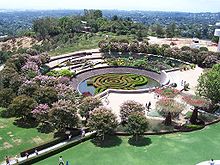 The Central Garden as seen from the Museum
The Central Garden as seen from the Museum
The 134,000-square-foot (12,400 m2) Central Garden at the Getty Center is the work of artist Robert Irwin. Planning for the garden began in 1992, construction started in 1996, and the garden was completed in December 1997.
Irwin was quoted as saying that the Central Garden “is a sculpture in the form of a garden, which aims to be art.” Water plays a major role in the garden. A fountain near the restaurant flows toward the garden and appears to fall into a grotto on the north garden wall. The resulting stream then flows down the hillside into the azalea pool. The designers placed rocks and boulders of varying size in the stream bed to vary the sounds from the flowing water. A tree-lined stream descends to a plaza, while the walkway criss-crosses the stream, which continues through the plaza, and goes over a stone waterfall into a round pool. A maze of azaleas floats in the pool, around which is a series of specialty gardens. More than 500 varieties of plant material are used for the Central Garden, but the selection is “always changing, never twice the same.”
After the original design, an outdoor sculpture garden, called the “Lower Terrace Garden” was added in 2007 on the west side of the central garden just below the scholar’s wing of the GRI building.

